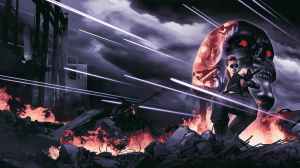Kara Zor-El, out of all DC Comics‘ many superheroes, has always seemed to have the most difficult time finding her place and purpose, and that’s not only because of her confusingly complicated continuity. As a character concept, Supergirl is often seen through the lens of her cousin Superman. Although Supergirl possesses plenty of adventures of her own, this still leaves her with questions of who she is and where she fits best. Enter Supergirl: Woman of Tomorrow #1—written by Tom King with art by Bilquis Evely and colors by Matheus Lopes. Kara Zor-El heads into space and finds herself on yet another quest for identity, but while it’s a strong enough start, there are enough missteps to make readers question if the hype for this much-anticipated miniseries was overblown.
Videos by ComicBook.com
The issue opens, in a sense, not at the beginning of the story but at the end. On an alien world orbiting a red sun, a young girl named Ruthye narrates events the reader is preparing to read having already lived them. As such, readers know this story will ultimately lead to Kara killing a man, but as Ruthye soon explains, that man murdered Ruthye’s father. From there, the story unfolds as Ruthye’s narration of her father’s murder and her subsequent quest for justice. To obtain justice, Ruthye seeks to hire an assassin and it’s that act which puts her in the path of Kara Zor-El who happens to be visiting a bar on this planet so she can get drunk during her 21st birthday.
There are some strong elements to this issue. For starters, this isn’t a standard superhero story as it focuses more upon Ruthye’s story, which has its own appeal as King writes Ruthye’s voice in very measured and specific fashion. While he provides her wisdom beyond her year, he excels at presenting her grieving process—showing Ruthye compartmentalizing her suffering and focusing on the task at hand; only breaking down when all hope is lost. While it’s painfully obvious that King is intending to pair Kara’s journey-of-self with Ruthye’s, it’s done here in a fashion that fits. It’s storytelling that makes sense, which deftly avoids some criticisms of King’s concurrent work.
The greatest strength of Supergirl: Woman of Tomorrow, however, is Evely’s art supported by Lopes’ colors. I do not say this in jest: you could strip away every word printed in this issue, leaving only the artwork, and you would still understand the full story—you might even find a better one. Every expression has a unique life and there is a dreaminess to the landscapes that feels both real and distant. If one could rate this book solely on the art, it would be a perfect score without hesitation.
Alas, comics are judged on more than their artwork and this comic does have some significant problems. King appears to have no real plan for or grasp of the character Supergirl based on how this issue presents her. Yes, the foreshadowed ending suggest some change, but it’s just as likely setting a target with a plan to fill in gaps along the way. I hesitate you can build this plane while flying it.
King also latches onto the idea of Kara as an angry, suffering person, though there have been an abundance of recent stories in which the character grows and processes some of her pain. It’s one thing to use trauma to tell important stories; it’s another to exploit and this feels like it may be the latter.
Perhaps the most egregious flaw in Supergirl: Woman of Tomorrow #1 is its need to twist the knife in Kara and readers just a bit more and does so by causing grievous harm to her beloved Krypto in a fashion that serves no purpose to the plot. Krypto only features as cute window dressing throughout this issue until harming an animal is considered good writing. It isn’t.
Supergirl: Woman of Tomorrow possesses potential. King has roughly outlined an intriguing story. As a reader, I want to know more about Ruthye’s story and why her father was murdered. But this is obviously Evely’s book at its best. Evely’s art is truly astounding and might be enough to bring readers back for more.
Published by DC Comics
On June 15, 2021
Written by Tom King
Art by Bilquis Evely
Colors by Matheus Lopes
Letters by Clayton Cowles
Cover by Bilquis Evely and Matheus Lopes








